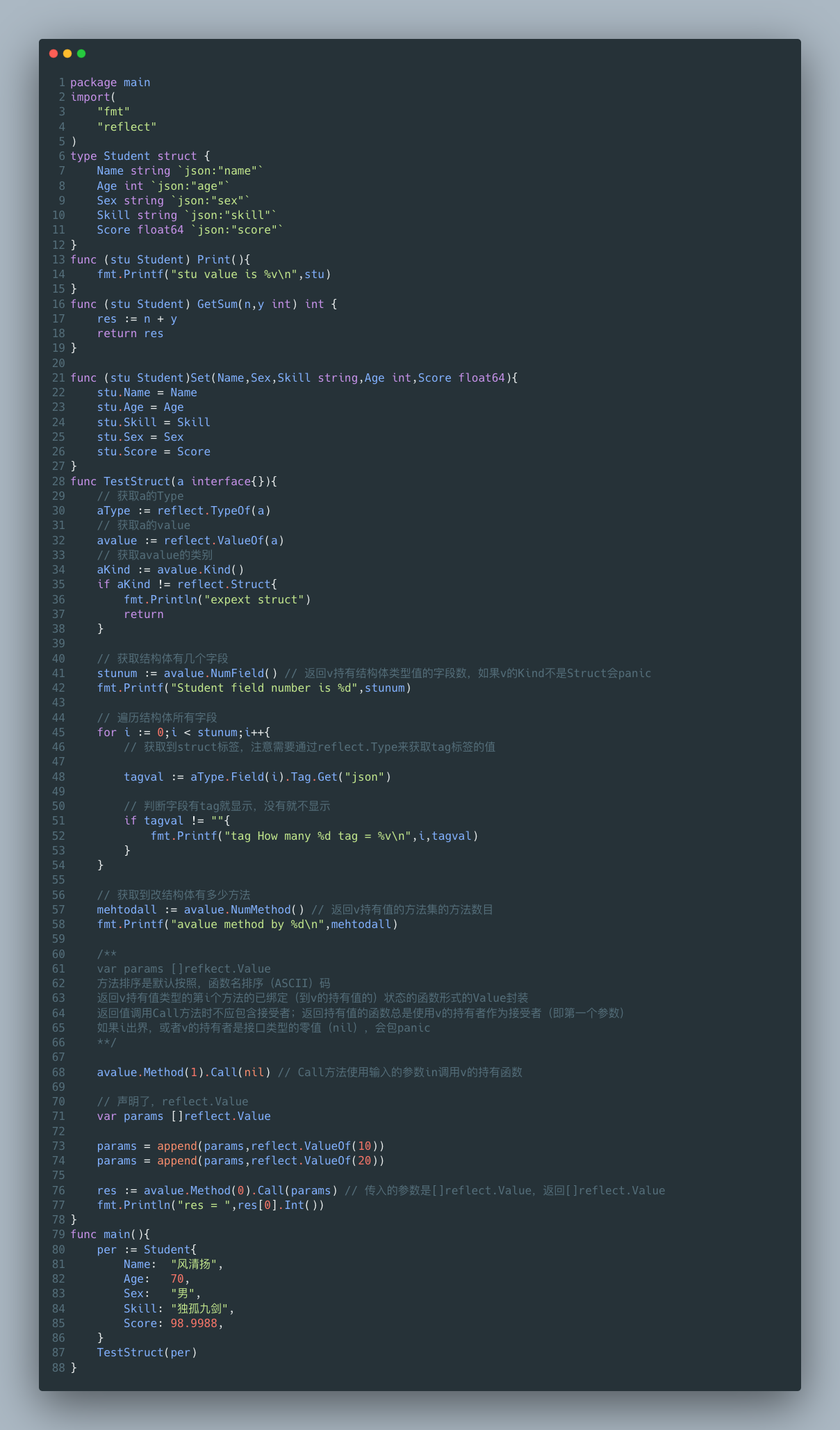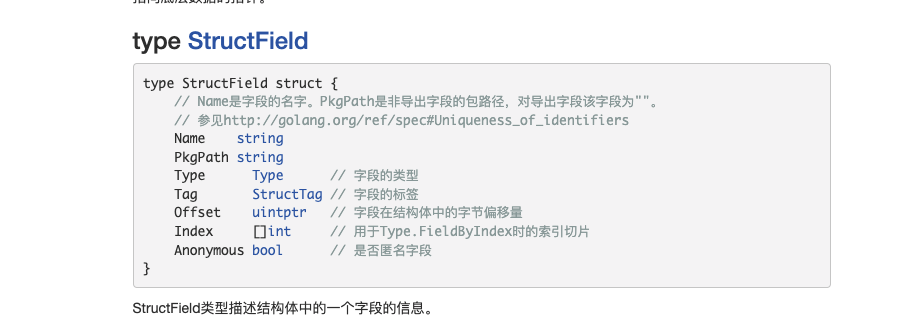### **第一题:**
使用反射来遍历结构体的字段,调用结构体的方法,并获取结构体标签的值

```
package main
import(
"fmt"
"reflect"
)
type Student struct {
Name string `json:"name"`
Age int `json:"age"`
Sex string `json:"sex"`
Skill string `json:"skill"`
Score float64 `json:"score"`
}
func (stu Student) Print(){
fmt.Printf("stu value is %v\n",stu)
}
func (stu Student) GetSum(n,y int) int {
res := n + y
return res
}
func (stu Student)Set(Name,Sex,Skill string,Age int,Score float64){
stu.Name = Name
stu.Age = Age
stu.Skill = Skill
stu.Sex = Sex
stu.Score = Score
}
func TestStruct(a interface{}){
// 获取a的Type
aType := reflect.TypeOf(a)
// 获取a的value
avalue := reflect.ValueOf(a)
// 获取avalue的类别
aKind := avalue.Kind()
if aKind != reflect.Struct{
fmt.Println("expext struct")
return
}
// 获取结构体有几个字段
stunum := avalue.NumField() // 返回v持有结构体类型值的字段数,如果v的Kind不是Struct会panic
fmt.Printf("Student field number is %d",stunum)
// 遍历结构体所有字段
for i := 0;i < stunum;i++{
// 获取到struct标签,注意需要通过reflect.Type来获取tag标签的值
tagval := aType.Field(i).Tag.Get("json")
// 判断字段有tag就显示,没有就不显示
if tagval != ""{
fmt.Printf("tag How many %d tag = %v\n",i,tagval)
}
}
// 获取到改结构体有多少方法
mehtodall := avalue.NumMethod() // 返回v持有值的方法集的方法数目
fmt.Printf("avalue method by %d\n",mehtodall)
/**
var params []refkect.Value
方法排序是默认按照,函数名排序(ASCII)码
返回v持有值类型的第i个方法的已绑定(到v的持有值的)状态的函数形式的Value封装
返回值调用Call方法时不应包含接受者;返回持有值的函数总是使用v的持有者作为接受者(即第一个参数)
如果i出界,或者v的持有者是接口类型的零值(nil),会包panic
**/
avalue.Method(1).Call(nil) // Call方法使用输入的参数in调用v的持有函数
// 声明了,reflect.Value
var params []reflect.Value
params = append(params,reflect.ValueOf(10))
params = append(params,reflect.ValueOf(20))
res := avalue.Method(0).Call(params) // 传入的参数是[]reflect.Value,返回[]reflect.Value
fmt.Println("res = ",res[0].Int())
}
func main(){
per := Student{
Name: "风清扬",
Age: 70,
Sex: "男",
Skill: "独孤九剑",
Score: 98.9988,
}
TestStruct(per)
}
```
<br>
<br>
**运行结果**
```
Student field number is 5tag How many 0 tag = name
tag How many 1 tag = age
tag How many 2 tag = sex
tag How many 3 tag = skill
tag How many 4 tag = score
avalue method by 3
stu value is {风清扬 70 男 独孤九剑 98.9988}
res = 30
```
<br>
**如上代码说明:**
(一)34行Kind:Kind返回v持有的值的分类,如果v是Value零值,返回值为Invalid

<br>
<br>
(二)41行NumField:就是将结构体的字段数量返回,reflect.value下的方法

<br>
<br>
(三)48行Field:就是将将结构体的第n个字段返回

<br>
<br>
(四)48行Field:改Field是Type的Field,也就是标签,

<br>
<br>
(五)56行NumMethod:会统计Student这个结构体中有多少个方法

<br>
<br>
(六)68行Method:改方法在value函数封装,所以,Method要传入结构体绑定的第几个方法进行调用,调用形式,也就是传入1,底层会按照方法名,进行ASCII进行顺序调用
返回v持有值类型的第i个方法的已绑定(到v的持有值的)状态的函数形式的Value封装

<br>
<br>
(七)62行Call:如果method调用的方法,不需要传参则Call(nil)即可

<br>
<br>
### **第二题:**
1)使用反射的方式来获取结构体的tag标签,遍历字段的值,修改字段值,调用结构体方法(要求:通过传递地址的方式完成在前面案例上修改即可)
- Golang语言之旅
- 第一章:初始小节以及安装
- 一:Golang语言特性
- 二:Windows上安装Go语言开发包
- 三:在Mac OS上安装Go语言开发包
- 第二章:GO语言注意事项
- 一:Dos的常用指令
- 第三章:Go初识小菜
- 一:Go语言之变量与常量
- 二:Go内置值-引用类型
- 三:基本的数据类型
- 四:字符串(char)
- 五:布尔类型(bool)
- 六:字符串类型(string)
- 七:基本数据类型的默认值
- 八:基本数据类型的互相转换
- 九:基本数据类型和string类型的相互转换
- 十:Golang指针
- 十一:值类型和引用类型
- 十二:标识符和命名规范
- 十三:系统保留关键字and预定义标识符
- 十四:fmt常用方法解析
- 第四章:Go运算符
- 一:运算符的基本介绍
- 二:算术运算符
- 2.1:算数运算符细节
- 三:关系运算符
- 3.1:关系运算符细节
- 四:逻辑运算符
- 4.1:逻辑运算符细节及案例
- 五:Go赋值运算符
- 5.1:案例演示赋值运算符的基本使用
- 5.2:赋值运算符的特点
- 六:Go位运算符
- 七:其他运算符
- 八:运算符的优先级
- 九:控制台输入语句
- 十:进制
- 十一:位运算
- 第五章:流程控制大纲
- 一:if语句
- 二:switch语句
- 三:for循环
- 第六章:函数-包-错误处理
- 一:Go函数
- 二:Go包
- 三:匿名函数
- 四:闭包
- 五:函数defer
- 六:函数参数的传递方式
- 七:变量的作用域
- 八:时间和日期相关函数
- 九:new和recover异常
- 十:数组(Array)切片(Section)
- 十一:切片(slice)
- 十二:3 数组的排序和查找
- 第七章:Map
- 第一节:Map基础认识
- 第二节:Map初始化和make
- 第三节:Map增删改查
- 第四节:Map的切片
- 第五节:Map的注意事项
- 第八章:面向对象(上)
- 第一节:结构体(值类型)
- 第二节:方法
- 第三节:面向对象编程应用实例
- 第九章:面向对象(下)
- 第一节:面向对象之抽象
- 第二节:面向对象之继承
- 第三节:面向对象之多态
- 第四节:接口
- 第十章:文件操作
- 第一节:文件基本介绍
- 第二季:写文件实例操作
- 第三节:JSON
- 第十一章:单元测试
- 第一节:单元测试介绍
- 第二节:单元测试案例
- 第三节:单元测试总结
- 第四节:单元测试案例
- 第十二章:goroutine和channel
- 第一节:goroutine基本介绍
- 第二节:goroutine入门案例
- 第三节:goroutione调度模型
- 第四节:Golang设置运行的CPU数量
- 第十二章:channel
- 第一节:channel基本介绍
- 第二节:channel基本使用
- 第三节:channel案例演示
- 第四节:channel 使用的注意事项
- 第五节:channel练习题
- 第六节:channel的遍历和关闭
- 第七节:goroutione和channel结合
- 第八节:channel细节处理
- 第十二章:并发模式
- 第十三章:反射reflect
- 第一节:反射基本介绍
- 第二节:反射重要的函数和概念
- 第三节:反射快速入门案例
- 第四节:反射注意事项
- 第五节:反射练习题
- 第六节:反射最佳实践
